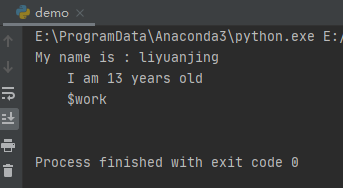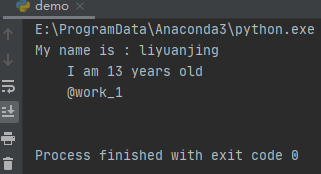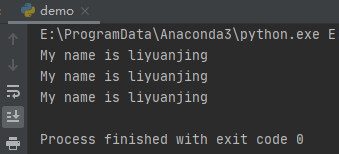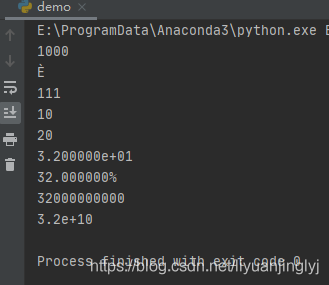Python的文本常量與字符串模板之string庫
一、前言
在程序中,有很多高效率的字符串處理方式,如果開發者能夠完全掌握這些高效的字符串處理,往往在開發者也能事半功倍。比如針對於字符串的處理,也是自然語言處理的基礎知識。
而python3中,處理字符串的庫為:string。本篇將詳細介紹各種字符串的高效處理方式。
二、首字母大寫
對於英文單詞組成的字符串來說,很多時候,我們需要對英文的首字母進行大寫的變更。如果沒有瞭解其高效率的函數,一般我們都通過循環,判斷空格,取空格後一位的字母,判斷其在ASCII中的編碼後,取其大寫替換掉該位置的字符串。
但是,python3中有一個函數可以直接將首字母大寫,該函數為capwords()。下面,我們來通過一小段代碼實現首字母大寫的字符串變更。
import string
s = "When he shewed the riches of his glorious kingdom and the honour of his excellent majesty many days, even an hundred and fourscore days"
print("原始字符串")
print(s)
result = string.capwords(s)
print("首字母大寫字符串")
print(result)
運行之後,我們會得到全大寫首字母字符串:

三、字符串模板
在string庫中,字符串模板函數為string.Template(),它可以用來拼接字符串。示例代碼如下:
import string
values = {
"name": "liyuanjing",
"age": "13",
}
s = """My name is : $name
I am $age years old
"""
template_str = string.Template(s)
print(template_str.substitute(values))
這裡,我們使用字符串模板string.Template,然後通過函數substitute()進行字符串替換。

不過,這裡有可能替換時values字典中沒有對應的key怎麼辦?string庫還給我們提供瞭一個函數safe_substitute()。
import string
values = {
"name": "liyuanjing",
"age": "13",
}
s = """My name is : $name
I am $age years old
$work
"""
template_str = string.Template(s)
print(template_str.safe_substitute(values))
因為字典沒有對應的值進行替換,所以會保留原始的字符串數據。效果如下:

四、高級模板
上面的模板使用方法是string庫默認提供的規則體系。其實,我們還可以自定義模板的使用匹配方法,具體代碼如下:
import string
class MyTemplate(string.Template):
delimiter = '@'
idpattern = '[a-z]+_[0-9]+'
values = {
"name_1": "liyuanjing",
"age_1": "13",
}
s = """My name is : @name_1
I am @age_1 years old
@work_1
"""
template_str = MyTemplate(s)
print(template_str.safe_substitute(values))
這裡,delimiter代表需要匹配的符號,默認符號”$”,博主替換成瞭‘@’。其次,idpattern是values對應的key名字規則,這裡用正則表達式規定,比如是”字符串_數字”。運行之後,效果如下:

五、format用法
基本用法
有過其他語言基礎的都應該或多或少接觸過format字符串替換。這裡,我們直接來看看其基本的使用方式:
print("My name is {}".format("liyuanjing"))#大括號匹配,按順序依次填充
print("My {1} is {0}".format("liyuanjing","name"))#數字匹配,按位置依次填充
print("My {name} is {tom}".format(tom="liyuanjing",name="name"))#關鍵字匹配,按關鍵字填充
運行之後,效果如下:

六、進階用法
format函數不僅可以匹配替換字符串,還可以通過它對其文本,或者取小數某幾位等等。下面,我們來看看這些用法如何實現。
print('{} and {}'.format('tom', 'Jerry'))
print('{:10s}'.format('*')) # 默認左對齊
print('{:>10s}'.format('*')) # 右對齊
print('{:^10s}'.format('*')) # 中間對齊
print('{:<10s}'.format('*')) # 左對齊
print('{} is {:.2f}'.format(3.411592653, 3.1415926))#取2位小數
values = {
"name_1": "liyuanjing",
"age_1": "13",
}
s = """My name is : {name_1}
I am {age_1} years old
"""
print(s.format(**values))
註釋已經非常詳細,這裡不在贅述。效果如下:

七、高階用法
format除瞭能做上面這些事情之外,還可以轉換進制以及ASCII碼符號等等。下面,我們來實現這些高階用法。
print('{:b}'.format(8))#:b轉換為二進制
print('{:c}'.format(200))#:c轉換Unicode字符串
print('{:d}'.format(111))#:d轉換十進制
print('{:o}'.format(8))#:o轉換八進制
print('{:x}'.format(32))#:x轉換十六進制
print('{:e}'.format(32))#:e轉換冪符號
print('{:%}'.format(0.32))#:%轉換百分值
print('{:n}'.format(32000000000))#:n就是數值
print('{:g}'.format(32000000000))#:n也是數值,不過特別大時轉換為冪科學計數
運行之後,效果如下:

到此這篇關於Python的文本常量與字符串模板string庫的文章就介紹到這瞭,更多相關Python string庫內容請搜索WalkonNet以前的文章或繼續瀏覽下面的相關文章希望大傢以後多多支持WalkonNet!
推薦閱讀:
- Python二分查找+字符串模板+textwrap模塊,
- Python 的 f-string 可以連接字符串與數字的原因解析
- python如何正確的操作字符串
- 分享3個非常實用的 Python 模塊
- Python 創建格式化字符串方法